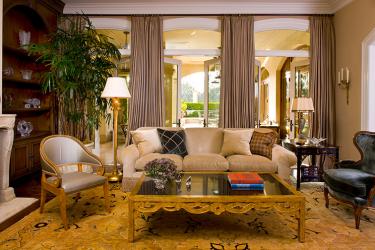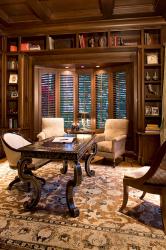Creating Structure: Traditional interior design begins in the room’s structural elements. Introducing structure into your space comes with details such as moldings, trims and railings that are commonly found in period homes, going back to the roots of the design style. These are easy to find if you’re updating or living in a historic home, but if you’re trying to emulate this look in a more modern setting, these details are simple enough to add through wood profiles on drywall or trompe l’oeil wallpaper.
The Beauty of Symmetry: Symmetry in any space is naturally soothing to the eye and helps a room feel more balanced and calm; as traditional interiors are meant to be functional, comfortable and family-friendly, symmetry is one of the simplest ways to achieve those feelings. If you ever question furniture placement or accessorizing, opt for buying doubles: two armchairs on either side of the fireplace, matching artwork or buying a pair of table lamps allow a room to feel harmonious rather than contrasting.
The Royal Treatment: Heavy, lined draperies are a staple in traditional interiors. However, just because the drapes are described as “heavy” doesn’t mean the room has to be! In fact, full-length or floor-to-ceiling window treatments create the illusion of a taller, more airy room. Layer the drapes with a sheer fabric underneath to pull across your windows during the day for adding light softening and privacy.
Classic Curves: While modern furniture and design leans toward clean and unfussy lines, traditional interiors embrace their curves! Think Cabriole legs, interesting upholstery and a delicate swirl. Adding curves into your furniture choices and patterns brings life to a traditional design without making it overwhelming.
Holding Pattern: The use of pattern is always important, but perhaps nowhere more than in traditional interiors. Walls are often painted in neutral tones, but can include subtly patterned wallpaper such as florals, stripes or damask. A rule-of-thumb for traditional interiors is to use patterns in textiles, especially in window treatments or upholstery. Don’t want to reupholster? Choose a vintage rug instead!
More is More: Traditional design isn’t the place to strive for minimalism; instead, undertake layering textures and patterns in a highly-curated and uncluttered way. With neutral walls or subtle patterns as your base, your decorations and accessories can shine. One way to add this element of grandeur is through light fixtures like crystal chandeliers or artistic sconces.









